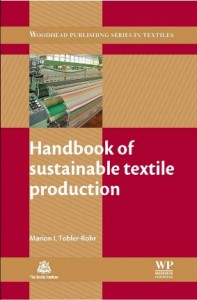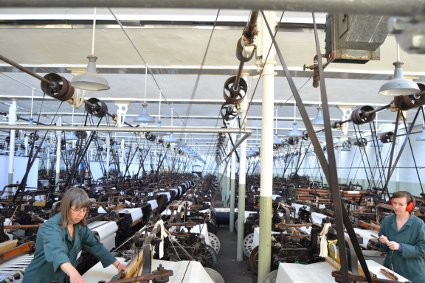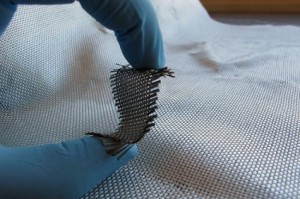 Handbook of sustainable textile production
Handbook of sustainable textile production
Author: Marion I. Tobler-Rohr
ISBN: 9780857091369
That the textile supply and production chain is complex is old news. That there are numerous specialities represented, all proud of their expertise, but weary of a dialogue with their peers, is not exactly a fresh insight either. All of this doesn’t help the sustainability agenda in fashion and textiles, where indeed inter- and transdiciplinary work and collaboration is possibly they single most important aspect for advancing the agenda.
With this in mind, the ‘Handbook of sustainable textile production‘ is a unique resources: by fostering the knowledge acquisition – through the presentation of facts, methods and formulas – across the different disciplines and specialities in the textile production chain, it prepares the ground for a factual, holistic discourse, and dissemination of best practise.
From agriculture to production and recyclingon on 496 pages this handbook discusses fundamental principles of sustainability. The book deals equally with legal issues as well as sustainability concepts as applied along the textile manufacturing chain, and in this way gives a deep up-to-date insight into environmentally friendly and socially responsible production in the textile and clothing industry.
The book is unsurpsingly packed with a delightful array of hard-facts, explanations and rationales for best practises as well as principle challenges to implement sustainability in textiles and fashion. In order to achieve this, the handbook is structured in 5 major sections, each of which adds one puzzle piece to the discussion:
- Sustainable development (SD) as a goal in production, marketing and trade:
This first chapter looks at what ‘sustainable development’ practically means in the context of business and industry. This chapter hence builds the common basis and understanding needed for a professional approach to the remainder of this book. In that sense, this book would loose some of its stength if this chapter was lacking as there is a notorious diversity in common understanding that often does not help the objectivised discours.
As a consequence, a relevant part of the chapter is dedicated to impact assessments and related themes that reach from legislation in vigor both in the US as well as the EU, to environmental management systems and international organisations active, and labelling standards relevant in this realm. - The Supply Chain of textiles:
This chapter starts off by looking at where the fibre is coming from, and finishes where it ultimately is going to – it covers the full depth of the supply chain from field to end-of-life.
In doing so, the following fibres are covered with their different characteristics, impacts and production stages: cotton, wool, man-made fibres such as specificially polyester and viscose.
These,then, are followed through the entire production chain: from fibre to yarn via spinning, to fabric via weaving and to finished product via chemical treatments and manufacturing.
At each stage the key technologies but also environmental impacts, including energy consumption, are detailed. Possibly most importantly, there are case studies scattered across the whole chapter giving tangible examples of production, manufacturing and the challenges that exists within a given context. - Product specification function and textile process technology:
This is where it gets really technical, and where indeed it becomes clear how much technical and hands-on knowledge in reality is needed to implement sustainability at every stage of the textile production chain.
The chapter covers topics such as quality, fibre characteristics and their relevance, weaving and spinning specifications and their impacts and relevance on the fabric, through to role and relevance of chemical treatments of the (nearly) finished fabric.
An important slot is thereby given to the Best Available Technoloy (BAT), defined as ‘the favourable technology to apply for the lowest environmental impact‘. Also mentioned is the limitation of said BATs due to the fact that they do not rely on Lifecycle Assessments (LCAs) but rather on a localised optimsation of processes.
Ample space is further given to the description of best practises in the supply chain of cotton, the running of mills, finishing, and – last but certainly not least given its importance across the lifecycle of a garment – consumption and care, including care scenarios. - Life cycle assessment (LCA) and ecological key figures (EKF):
LCAs are a repeating issue in the discussions of textile experts. The last such discussion is currently being held over the (un)sustainability of wool, where the MADE-BY fibre benchmark is disputed by no one less than the International Wool Board.
That LCAs are key in the assessment of sustainability for textiles and fashion is evident: over 75% of impact stems from the usage cycle alone. Hence, LCAs are key to the discussion. As a consequence, the whole chapter is dedicated to the subject.
It starts off with reviewing the concepts of LCAs, and briefly detailing different existing methods for the task. This more theoretical introduction is then complemented by a set of 8 case studies about the practicalities and the different process steps and step results.
Given that LCA is in itself a fairly sophisticated approach, the chapter finishes by introducing a slightly more straight forward, if not to say simplified, version of an LCA entitled ‘Ecological Key Figures’ (EKF) method. The key point here is that for an LCA individual process data per product is of relevance, yet such data is hardly available within companies.
The theory and application of the EKF method is then presented in full depth including the different calculation and result metrics to be expected. - Product development and marketing: Management and communications:
In this chapter the perspectives are inverted: rather than bottom up (i.e. fibre to product) it is, so to speak, top down (consumer to product).
The chapter sets out to describe the structure of the industry as a whole from the various production clusters to the retail structures that exist in different (Western) countries.
The picture is complented with an evaluation of global trade patterns under GATT, pre-and post Multi Fibre Agreement. Consumer preferences are added to the puzzle in their full beauty: from price, over quality to branding, colours and cuts, material and care properties.
One of the most interesting sub-chapters here is the one dedicated to product development and marketing, where the many ways the sustainability chain – on the product side as well as on the consumer side – both originates and finishes.


In conclusion it can be said that, this ‘Handbook of sustainable textile production‘ is without a doubt the most thorough book on the full range of issues encountered in the sustainability discussion in textiles and fashion.
While the book isn’t exactly an easy read – after all it is both an academic as well as a practitioner’s book, and as dense as we like them for such a target public, it is very much worth its price and space on the book shelf.
There are but two issues that merit a brief mention in terms of possible improvement.
First, it should be made clear in the definition, that ‘sustainable development’ is understood in the realms of this book to be focused on environmental sustainability.
And second, the case studies are all heavily based on Western (US, Swiss, German) industrial units. With but a minority of textile production taking place in the West still, and nearly everything coming out of China in the present, embedding for example the legal issues arrising from such situations would have been relevant to include. While not all side effects of globalisation can of course be suitably covered in the few pages available, not mentioning these aspects at all is problematic.
—
This book is available from your nearest book store as well as online from Amazon.

